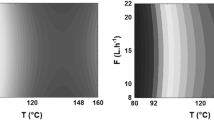Abstract
Waxes are natural components of sunflower oils, consisting mainly of esters of FA with fatty alcohols, that are partially removed in the winterization process during oil refining. The wax composition of sunflower seed as well as the influence of processing on the oil wax concentration was studied using capillary GLC. Sunflower oils obtained by solvent extraction from whole seed, dehulled seed, and seed hulls were analyzed and compared with commercial crude and refined oils. The main components of crude sunflower oil waxes were esters having carbon atom numbers between 36 and 48, with a high concentration in the C40−C42 fraction. Extracted oils showed higher concentrations of waxes than those obtained by pressing, especially in the higher M.W. fraction, but the wax content was not affected significantly by water degumming. The hull contribution to the sunflower oil wax content was higher than 40 wt%, resulting in 75 wt % in the crystallized fraction. The oil wax content could be reduced appreciably by hexane washing or partial dehulling of the seed. Waxes in dewaxed and refined sunflower oils were mainly constituted by esters containing fewer than 42 carbon atoms, indicating that these were mostly soluble and remained in the oil after processing.
Similar content being viewed by others
References
Morrison, W.H., III, Variation in the Wax Content of Sunflower Seeds with Location and Hybrids, J. Am. Oil Chem. Soc. 60:1013–1015 (1983).
Ramos Ayerbe, F., and F. Rodriguez Berbel, A Study on the Recovery of Byproducts from the Dewaxing of Sunflower Oils of National Production, Grasas Aceites 36:1–4 (1985).
Mariani, C., and E. Fedeli, Minor Components of Vegetable Oils: Non-glyceridic Esters, Riv. Ital. Sostanze Grasse 66:397–401 (1989).
Brevedan, M.I.V., A.A. Carelli, and G.H. Crapiste, Changes in Composition and Quality of Sunflower Oils During Extraction and Degumming, Grasas Aceites 51:417–423 (2000).
Recsec, K., Z. Kemény, K. Kõvári, and J. Denise, Investigation of Nonglyceridic Esters of Vegetable Oils, in Advances in Oils and Fats, Antioxidants, and Oilseed By-Products, Vol. 2 in the Proceedings of the World Conference on Oilseed and Edible Oils Processing, edited by S.S. Koseoglu, K.C. Rhee, and R.F. Wilson, AOCS Press, Champaign, 1998, pp. 342–345.
Morrison, W.H., III, and J. Robertson, Solvent Winterization of Sunflower Seed Oil, J. Am. Oil Chem. Soc. 52:148–150 (1975).
Morrison, W.H., III, Rapid Determination of Wax in Sunflower Seed Oil, 59:284–285 (1982).
Official Methods and Recommended Practices of the American Oil Chemists’ Society, 4th edn., edited by D. Firestone, AOCS Press, Champaign, 1993.
Standard Methods for the Analysis of Oils, Fats and Derivatives, 7th. edn., edited by C. Paquot and A. Hautfenne, International Union of Pure and Applied Chemistry, Blackwell Scientific Publications, Oxford, 1992.
Martini, S., and M.C. Añón, Determination of Wax Concentration in Sunflower Seed Oil, J. Am. Oil Chem. Soc. 77:1087–1092 (2000).
European Economic Community (EEC), Commission Regulation EEC No. 183/93 of 29 January 1993, on the Characteristics of Olive and Olive Pomace Oils and on Their Analytical Methods, Off J. Eur. Commun. L22:61–65 (1993).
Nota, G., D. Naviglio, R. Romano, V. Sabia, S.S. Musso, and C. Improta, Determination of the Wax Ester Content in Olive Oils. Improvement in the Method Proposed by EEC Regulation 183/93, j. Agric. Food Chem. 47:202–205 (1999).
Amelio, M., R. Rizzo, and F. Varazini, Separation of Wax Esters from Olive Oils by High-Performance Liquid Chromatography, J. Am. Oil Chem. Soc. 70:793 (1993).
Grob, K., M. Lanfranchi, and C. Mariani, Determination of Free and Esterified Esterols and of Wax Esters in Oils and Fats by Coupled Liquid Chromatography-Gas Chromatography, J. Chromatogr. 471:397–405 (1989).
León Camacho, M., and A. Cert, Suggestions for the Application of Some Analytical Methods Included in the Regulation EEC 2568/91 Relative to the Characteristics of the Olive Oils and Olive Pomace Oils, Grasas Aceites 45:395–401 (1994).
EEC, Commission Regulation EEC No. 2568/91 of 11 July 1991, on the Characteristics of Olive and Olive Pomace Oils and on Their Analytical Methods, Off. J. Eur. Commun. L248:10–14 (1991).
Morrison, W.H., III, Effective Method for the Reduction of Waxes in Sunflower Seed Oil, J. Am. Oil Chem. Soc. 59:519–520 (1982).
Liu, H., R. Przybylski, K. Dawson, N.A.M. Eskin, and C.G. Biliaderis, Comparison of the Composition and Properties of Canola and Sunflower Oil Sediments with Canola Seed Hull Lipids, 73:493–498 (1996).
Author information
Authors and Affiliations
Corresponding author
About this article
Cite this article
Carelli, A.A., Frizzera, L.M., Forbito, P.R. et al. Wax composition of sunflower seed oils. J Amer Oil Chem Soc 79, 763–768 (2002). https://doi.org/10.1007/s11746-002-0556-9
Received:
Accepted:
Issue Date:
DOI: https://doi.org/10.1007/s11746-002-0556-9




